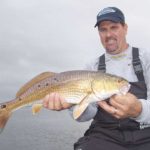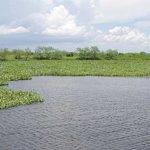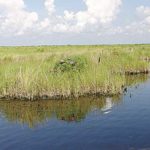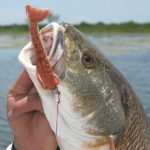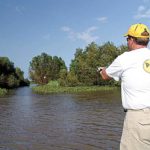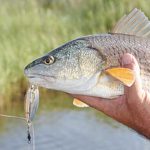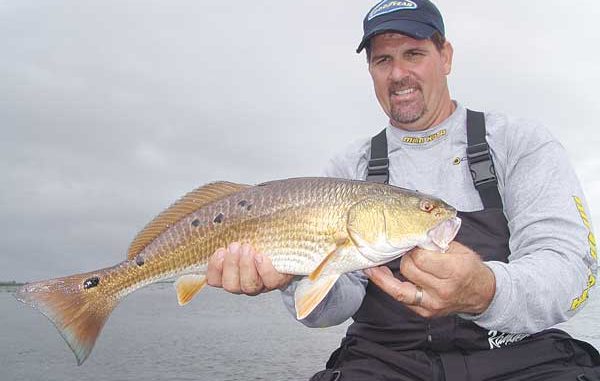
Can’t catch reds out of this popular port? Follow this guide, and you won’t be buying hamburgers and hot dogs for the barbecue pit.
The sign from a long-departed marina reads, “Welcome to the End of the World,” but for redfish anglers, Delacroix looks more like the pot of gold at the end of a rainbow.
It takes only about 45 minutes to drive from New Orleans to Delacroix Island (actually mainland cut with bayous), but this small, fishing-centered town sits a pretty good ways from anything else with a mailbox. Indeed, where State Road 300 concludes at the southern end of St. Bernard Parish, you’ll find nothing but a jigsaw puzzle of fertile marshes and rambling waterways scattered to the coastal fringes of Breton Sound.
Tucked between the Mississippi River-Gulf Outlet to the north and the Mississippi River to the south, the sprawling region flourishes with grass-lined duck ponds, quiet sloughs, expansive lakes, natural bayous and pipeline canals.
With local reds eating more shrimp and crabs, this labyrinthine vastness may not produce the pogie-fattened bruisers common to the heralded Venice marshes near the delta’s end. However, in terms of area and sheer numbers, Delacroix dominates.
A major factor favoring this region is the Mississippi River’s influence — actually, the lack thereof. Sitting outside the levees, Delacroix doesn’t experience the seasonal fluctuations of water height and clarity that can fiddle with Venice patterns. The advantage: consistency.
“You don’t have the river to deal with, so you’re not subject to salinity changes,” said Covington angler Sam Swett. “The (Delacroix) patterns are more predictable season to season, whereas if the snow melts a little early up north, the river may rise a little more in the spring.”
Now, a managed intake of river water is a good thing and that’s the job of a freshwater diversion project in nearby Caernarvon. Located on the east bank of the river near the St. Bernard-Plaquemines Parish line, the structure routes controlled volumes of fresh water, along with nutrients and sediment, through the marsh and out to the Breton Sound estuary. The benevolent flow aids coastal shellfish growth, while fostering marsh vegetation and countering habitat loss caused by tidal erosion.
With manmade devices complementing the natural network of Delacroix’s water system, flourishing hydrilla, milfoil, coontail, hyacinth and eel grass provide nursery habitat for baitfish and crustaceans, along with prime redfish feeding grounds.
Capt. Charlie Thomason, who runs a guide service and lodge in neighboring Hopedale, described Delacroix as a place that’s kind to first-timers and rewarding to those who know their game.
“Any day, two fishermen should be able to catch 20 redfish between the two of them without any trouble,” he said. “But when they really get on them, they should catch 80 fish.”
Redfish are rarely a picky species, but dense populations equal intense feeding competition, and that means the Delacroix fish live by a get-while-the-getting’s-good mentality.
“It’s just sheer numbers,” Thomason said. “The competition is always a factor, so these fish are always aggressive. They know that if they see something, they’d better eat it or someone else will.”
When and where
Thomason said he catches redfish throughout the Delacroix marsh, but he finds his best action within a 3-square-mile area around Four Horse Lake.
“This area gets a lot of water flow, and all of the small ponds and bayous are like veins through the marsh,” he said. “With all the grass we have there and the baitfish, all those variables come together to make a pristine habitat for those fish to live in year-round.”
Other hotspots include Lake John, Lake Lery, Grand Lake and Lake Robin. To newcomers, it all looks fishy, but the redfish definitely have their preferences. Swett prefers fishing in and around natural bayous that bring food sources with the tides. Oyster beds are also a good sign, as shellfish filter marsh water and yield a cleaner environment.
When the freshwater diversion project releases river water — mostly in the spring — Swett avoids muddy conditions by leaving the main canals and bayous and heading into backwater ponds where coontail and hydrilla further filter the water. In this tidal system, daily flushing keeps the oxygen content freshened, but it’s best to avoid the choked and stagnant water of dead-end canals or sloughs during the summer months.
Conversely, the tucked-away spots deep in the inner marsh are good bets for winter when dissolved oxygen content is higher and protected water is warmer. Often targeting the outside bends of bayous and canals, Swett looks for what he calls the two-step-12 scenario: “Two steps off the bank and you’re in 12 feet of water,” he said. “Reds will lie in that deep water and look for food to wash over them.”
Seasonal patterns
May to November provides steady action, as the fish move around to find the best water and the most food. Fish bite during the cooler months, too, but sporadic cold fronts can booger the patterns. Here’s a glance at seasonal opportunities.
• Winter: Reds retreat to the deep sanctuaries of the inner marsh, so work ponds draining into bayous and dead-end canals, where the fish find stable temperatures. Work jigs slowly during cold spells, and switch to gold spoons and spinnerbaits on nearby flats during warm spells. When winter fish are sluggish, scented baits can stimulate a bite.
• Spring: Many redfish move to the outer edges of bays and lakes such as Oak River Bay and Lake Campo to feast on the mullet, pogies and shrimp gathering there. Use suspending baits like the MirrOlure Catch 5, and shallow diving crankbaits (Mann’s Baby 1-Minus) and topwaters such as the Rapala Skitterwalk or Lucky Craft Sammy.
Tournament teams know that reds don’t always connect on topwater strikes, but a fish that misses will usually grab the first subsurface target it sees. Clacking corks with jigs, soft jerkbaits or Berkley Gulp! Shrimp will help attract attention when abundant natural forage occupies the fish’s attention. Spring redfish eat a lot of peeler crabs (molting blue crabs), so soft-plastic crab bodies on ¼-ounce jigheads or weighted hooks will also produce.
• Summer: Hot, humid and still, this is a good time for sight fishing grass lines in the duck ponds and lakes. Target points, shoreline breaks, small islands carved by hurricanes and passes in matted weeds where current rolls through. On falling tides, look for reds around the mouths of run-out creeks draining shallow ponds. Gold spoons, buzz baits, topwaters and weedless-rigged soft-plastic jerkbaits work well in these scenarios.
Thick mats of vegetation may look like a solid wall, but there’s usually a foot or more of clearance below, and that’s a classic summertime redfish hideout. The weeds emit oxygen into surrounding water, shelter reds from intense heat and offer prime ambush positions from which to grab tide-borne meals.
Try slinging weedless-rigged soft-plastic jerkbaits, floating worms or Snagproof Frogs across the mats and working the baits through open gaps where predators ambush prey. If you don’t want to wait for the reds to rise, try punching through the mats with heavy jigs or Texas-rigged plastics with 1- to 1½-ounce tungsten bullet weights. (You’ll need a stout rod and heavy braid to raise 6 pounds of redfish and 10 pounds of weeds.) Swett works the edges of weed beds with spoons, spinnerbaits, and grubs.
• Fall: Look for big schools of reds ganging up and holding at the mouths of all major bayous. Shrimp are moving back out into the Gulf, and reds stage along the banks to hammer the shrimp as the tide moves them out.
As fall continues, Swett moves back into feeder creeks leading toward the inner marsh. He looks for schools of finger mullet and storm minnows pushed into the marsh by the abnormally high tides that come with each hurricane season. Topwaters, jigs, spinnerbaits and spoons will cover the bases for fall.
As Thomason notes, the Delacroix marsh offers a user-friendly training facility with a sizable staff of native instructors.
“This area is really good for learning how to catch redfish because the fish are so cooperative,” he said. “It’s a good place to come and school yourself on how to work different baits.”
Don’t worry if you botch a cast, miss a hook-up or drop a fish. In the vast Delacroix marsh, it’s very unlikely that you’ll have an audience. More importantly, your next opportunity is probably just a cast away.
